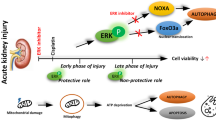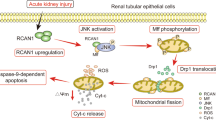Abstract
Mechanisms underlying the tissue-specific impact of cardiotonic steroids (CTS) on cell survival and death remain poorly understood. This study examines the role of Na+,K+-ATPase α subunits in death of Madin-Darby canine kidney (MDCK) cells evoked by 24-h exposure to ouabain. MDCK cells expressing a variant of the α1 isoform, CTS-sensitive α1S, were stably transfected with a cDNA encoding CTS-resistant α1R-Na+,K+-ATPase, whose expression was confirmed by RT–PCR. In mock-transfected and α1R-cells, maximal inhibition of 86Rb influx was observed at 10 and 1000 μM ouabain, respectively, thus confirming high abundance of α1R-Na+,K+-ATPase in these cells. Six-hour treatment of α1R-cells with 1000 μM ouabain led to the same elevation of the [Na+]i/[K+]i ratio that was detected in mock-transfected cells treated with 3 μM ouabain. However, in contrast to the massive death of mock-transfected cells exposed to 3 μM ouabain, α1R-cells survived after 24-h incubation with 1000 μM ouabain. Inversion of the [Na+]i/[K+]i ratio evoked by Na+,K+-ATPase inhibition in K+-free medium did not affect survival of α1R-cells but increased their sensitivity to ouabain. Our results show that the α1R subunit rescues MDCK cells from the cytotoxic action of CTS independently of inhibition of Na+,K+-ATPase-mediated Na+ and K+ fluxes and inversion of the [Na+]i/[K+]i ratio.




Similar content being viewed by others
References
Skou JC (1960) Further investigation on a Mg2+ + Na+-activated adenosinetriphosphatase possibly related to the active transport of Na+ and K+ across the nerve cell membrane. Biochim Biophys Acta 42:6–23
Schoner W, Scheiner-Bobis G (2007) Endogenous and exogenous cardiac glycosides: their role in hypertension, salt metabolism, and cell growth. Am J Physiol Cell Physiol 293:C509–C536
Kawamura A, Guo J, Itagaki Y, Bell C, Wang Y, Haupert J, Garner T, Magil S, Gallagher RT, Berova N, Nakanishi K (1999) On the structure of endogenous ouabain. Proc Natl Acad Sci USA 96:6654–6659
Bagrov AY, Fedorova OV, Dmitrieva RI, Howald WN, Hunter AP, Kuznetsova EA, Shpen VM (1998) Characterization of a urinary bufodielnolide Na, K-ATPase inhibitor in patients after acute myocardial infarction. Hypertension 31:1097–1103
Komiyama Y, Dong XH, Hishimura N, Masaki H, Yoshika M, Masuda M, Takahashi H (2005) A novel endogenous digitalis, telocinobufagin, exhibits elevated plasma levels in patients with terminal renal failure. Clin Biochem 38:36–45
Lichtstein D, Gati I, Samuelov S, Berson D, Rozenman Y, Landau L, Deutsch J (1993) Identification of digitalis-like compounds in human cataractous lenses. Eur J Biochem 216:261–268
Blaustein MP, Zhang J, Chen L, Hamilton BP (2006) How does salt retention raise blood pressure? Am J Physiol Regul Integr Comp Physiol 290:R514–R523
Bagrov AY, Shapiro JI, Fedorova OV (2009) Endogenous cardiotonic steroids: physiology, pharmacology, and novel therapeutic targets. Pharmacol Rev 61:9–38
Lingrel JB, Argüello JM, Van Huysse JW, Kuntzweiler TA (1997) Cation and cardiac glycoside binding sites of the Na, K-ATPase. Ann NY Acad Sci 843:194–206
Dostanic I, Paul RJ, Lorenz JN, Theriault S, Van Huysse JW, Lingrel JB (2005) The α2-isoform of Na-K-ATPase mediates ouabain-induced hypertension in mice and increased vascular contractility in vitro. Am J Physol Heart Circ Physiol 288:H477–H485
Dostanic-Larson I, Van Huysse JW, Lorenz JN, Lingrel JB (2005) The highly conserved cardiac glycoside binding site of Na, K-ATPase plays a role in blood pressure regulation. Proc Natl Acad Sci USA 102:15845–15850
Lorenz JN, Loreaux EL, Dostanic-Larson I, Lasko V, Schnetzer JR, Paul RJ, Lingrel JB (2008) ACTH-induced hypertension is dependent on the ouabain-binding site of the alpha2-Na+, K+-ATPase subunit. Am J Physiol Heart Circ Physiol 295:H273–H280
Hou X, Theriault SF, Dostanic-Larson I, Moseley AE, Lingrel JB, Wu H, Dean S, Van Huysse JW (2009) Enhanced pressor response to increased CSF sodium concentration and to central angiotensin I in heterozygous α2 Na, K-ATPase knockout mice. Am J Physiol Regul Integr Comp Physiol 295:R1427–R1438
Dostanic I, Lorenz JN, Schultz JEJ, Grupp IL, Neumann JC, Wani MA, Lingrel JB (2003) The α2 isoform of Na, K-ATPase mediates ouabain-induced cardiac inotropy in mice. J Biol Chem 278:53026–53034
Radzyukevich TL, Lingrel JB, Heiny JA (2009) The cardiac glycoside binding site of the Na, K-ATPase α2 isoform plays a role in the dynamic regulation of active transport in skeletal muscle. Proc Natl Acad Sci USA 106:2565–2570
Wansapura AN, Lasko V, Xie Z, Fedorova OV, Bagrov AY, Lingrel JB, Lorenz JN (2009) Marinobufagenin enhances cardiac contractility in mice with ouabain-sensitive α1 Na+-K+-ARPase. Am J Physiol Heart Circ Physiol 296:H1833–H1839
Loreaux EL, Kaul B, Lorenz JN, Lingrel JB (2008) Ouabain-sensitive α1 Na, K-ATPase enhances natriuretic response to saline load. J Am Soc Nephrol 19:1947–1954
Falciola J, Volet B, Anner RM, Moosmayer M, Lacotte D, Anner BM (1994) Role of cell membrane Na, K-ATPase for survival of human lymphocytes in vivo. Biosci Rep 14:189–204
Orlov SN, Taurin S, Tremblay J, Hamet P (2001) Inhibition of Na+, K+ pump affects nucleic acid synthesis and smooth muscle cell proliferation via elevation of the [Na+]i/[K+]i ratio: possible implication in vascular remodeling. J Hypertens 19:1559–1565
Orlov SN, Thorin-Trescases N, Kotelevtsev SV, Tremblay J, Hamet P (1999) Inversion of the intracellular Na+/K+ ratio blocks apoptosis in vascular smooth muscle at a site upstream of caspase-3. J Biol Chem 274:16545–16552
Akimova OA, Mongin AA, Hamet P, Orlov SN (2006) The rapid decline of MTT reduction is not a marker of death signaling in ouabain-treated cells. Cell Mol Biol 52(8):71–77
Ledbetter ML, Young GJ, Wright ER (1986) Cooperation between epithelial cells demonstrated by potassium transfer. Am J Physiol 250:C306–C313
Bolivar JJ, Lazaro A, Fernandez S, Stefani E, Pena-Cruz V, Lechene C, Cereijido M (1987) Rescue of a wild-type MDCK cell by a ouabain-resistant mutant. Am J Physiol 253:C151–C161
Orlov SN, Thorin-Trescases N, Pchejetski D, Taurin S, Farhat N, Tremblay J, Thorin E, Hamet P (2004) Na+/K+ pump and endothelial cell survival: [Na+]i/[K+]i-independent necrosis triggered by ouabain, and protection against apoptosis mediated by elevation of [Na+]i. Pflugers Archiv 448:335–345
Pchejetski D, Taurin S, der Sarkissian S, Lopina OD, Pshezhetsky AV, Tremblay J, DeBlois D, Hamet P, Orlov SN (2003) Inhibition of Na+, K+-ATPase by ouabain triggers epithelial cell death independently of inversion of the [Na+]i/[K+]i ratio. Biochem Biophys Res Commun 301:735–744
Contreras RG, Flores-Maldonado C, Lazaro A, Shoshani L, Flores-Benitez D, Larre I, Cereijido M (2004) Ouabain binding to Na+, K+-ATPase relaxes cell attachment and sends a specific signal (NACos) to the nucleus. J Membr Biol 198:147–158
Akimova OA, Bagrov AY, Lopina OD, Kamernitsky AV, Tremblay J, Hamet P, Orlov SN (2005) Cardiotonic steroids differentially affect intracellular Na+ and [Na+]i/[K+]i-independent signaling in C7-MDCK cells. J Biol Chem 280:832–839
Orlov SN, Hamet P (2006) The death of cardiotinic steroid-treated cells: evidence of Na+i, K+i-independent H+i-sensitive signaling. Acta Physiologica (Oxf) 187:231–240
Rajasekaran SA, Gopal J, Willis D, Espineda C, Twiss JL, Rajasekaran AK (2004) Na, K-ATPase β1-subunit increases the translation efficiency of the α1-subunit in MCV-MDCK cells. Mol Biol Cell 15:3224–3232
Jewell EA, Lingrel JB (1991) Comparison of the substrate dependence properties of the rat Na, K, ATPase α1, α2, and α3 isoforms expressed in HeLa cells. J Biol Chem 266:16925–16930
Contreras RG, Flores-Benitez D, Flores-Maldonado C, Larre I, Shoshani L, Cereijido M (2006) Na+, K+-ATPase and hormone ouabain: new roles for an old enzyme and an old inhibitor. Cell Mol Biol 30:31–40
Contreras RG, Shoshani L, Flores-Maldonado C, Lazaro A, Cereijido M (1999) Relationship between Na+, K+-ATPase and cell attachment. J Cell Sci 112:4223–4232
Kroemer G, El-Diery WS, Golstein P, Peter ME, Vaux D, Vandenabeele P, Zhivotovsky B, Blagosklonny MV, Malorni W, Knight RA, Placentini M, Nagata S, Melino G (2005) Classification of cell death: recommendations of the Nomeclature Committee on Cell Death. Cell Death Differ 12:1463–1467
Xie Z, Askari A (2002) Na+/K+-ATPase as a signal transducer. Eur J Biochem 269:2434–2439
Hegyvary C, Jorgensen PL (1981) Conformational changes of renal sodium plus potassium ion transport adenosine triphosphatase labeled with fluorescein. J Biol Chem 256:6296–6303
Haas M, Wang H, Tian J, Xie Z (2002) Src-mediated inter-receptor cross-talk between the Na+, K+-ATPase and epidermal growth factor receptor relays the signal from ouabain to mitogen-activated protein kinases. J Biol Chem 277:18694–18702
Wang H, Haas M, Liang M, Cai T, Tian J, Li S, Xie Z (2004) Ouabain assembles signaling cascade through the caveolar Na+, K+-ATPase. J Biol Chem 279:17250–17259
Liu J, Kesiry R, Periyasamy SM, Malhotra D, Xie Z, Shapiro JI (2004) Ouabain-induced endocytosis of plasmalemmal Na/K-ATPase in LLC-PK1 cells by clathrin-dependent mechanism. Kidney Int 66:227–241
Miakawa-Naito A, Uhlén P, Lal M, Aizman O, Mikoshiba K, Brismar H, Zelenin S, Aperia A (2003) Cell signaling microdomain with Na, K-ATPase and inositol 1, 4, 5-triphosphate receptor generates calcium oscillations. J Biol Chem 278:50355–50361
Akimova OA, Lopina OD, Hamet P, Orlov SN (2005) Search for intermediates of Na+, K+-ATPase-mediated [Na+]i/[K+]i-independent death signaling triggered by cardiotonic steroids. Pathophysiology 12:125–135
Akimova OA, Hamet P, Orlov SN (2008) [Na+]i/[K+]i-independent death of ouabain-treated renal epithelial cells is not mediated by Na+, K+-ATPase internalization and de novo gene expression. Pflügers Archiv 455:711–719
Lefkowitz RJ (2007) Seven transmembrane receptors: something old, something new. Acta Physiol 190:9–19
Akimova OA, Lopina OD, Rubtsov AM, Gekle M, Tremblay J, Hamet P, Orlov SN (2009) Death of ouabain-treated renal epithelial cells: evidence for p38 MAPK-mediated Na +i /K +i -independent signaling. Apoptosis 14:1266–1273
Blanco G, Mercer RW (1998) Isozymes of the Na-K-ATPase: heterogeneity in structure, diversity in function. Am J Physiol 275:F633–F650
Pierre SV, Sottejeau Y, Gourbeau JM, Sanchez G, Shidyak A, Bianco VG (2008) Isoform-specificity of Na, K-ATPase-mediated ouabain signaling. Am J Physiol Renal Physiol 294:F859–F866
Acknowledgments
This work was supported by grants from the Canadian Institutes of Health Research (MOP-81392 to SNO, JT and PH), Heart and Stroke Foundation of Quebec (to SNO, JT and PH) and Heart and Stroke Foundation of Ontario (NA-6324 to JWV) Canada. OA is a recipient of a fellowship from the Kidney Foundation of Canada.
Author information
Authors and Affiliations
Corresponding author
Rights and permissions
About this article
Cite this article
Akimova, O.A., Tremblay, J., Van Huysse, J.W. et al. Cardiotonic steroid-resistant α1-Na+,K+-ATPase rescues renal epithelial cells from the cytotoxic action of ouabain: evidence for a Na +i ,K +i -independent mechanism. Apoptosis 15, 55–62 (2010). https://doi.org/10.1007/s10495-009-0429-4
Published:
Issue Date:
DOI: https://doi.org/10.1007/s10495-009-0429-4




